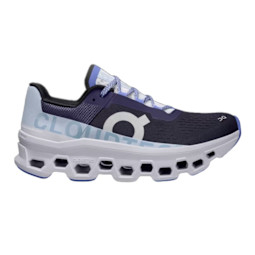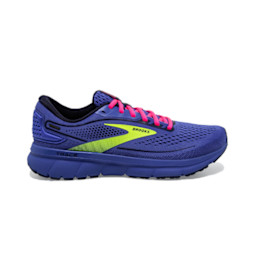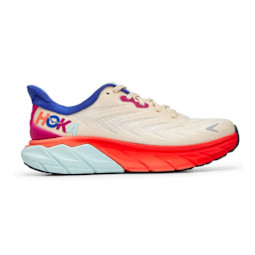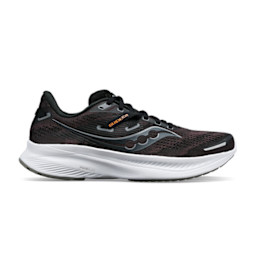The 9 Best Long Distance Running Shoes, With Recommendations From Podiatrists

- Best for wide feet: Altra Torin 7
- Best for impact absorption: On Cloud Monster
- Best for narrow feet: Nike Vaporfly 3
- Best for high arches: Brooks Ghost 15
- Best for flat feet: HOKA Arahi
- Best for stability: Saucony Triumph
- Best cushioned: HOKA Bondi 8
- Best for trail running: HOKA Speedgoat 5
- Best for women: ASICS Gel Nimbus 24
Long distance running can help you live a longer, healthier life—but without the right shoes, you won’t get very far. Per podiatrists, the best long distance running shoes address the unique demands of extended mileage.
Every podiatrist we interviewed agreed that if you’re running in a shoe that’s not fitting your foot type, you can cause yourself foot pain, injuries, and issues like blisters, calluses, and hot spots due to the prolonged friction and moisture.
The good news? The best long distance running shoes offer a world of benefit.
Research shows significantly less reports of heart disease, diabetes, and carcinoma1 in long distance runners than the general population, so it’s definitely worth investing in a good pair of kicks to get you moving.
What to look for in long distance running shoes
The more miles you run, the more important it is to make sure your feet are staying healthy and comfortable. Hillary Brenner, a podiatrist and founder of Dr. Brenner's RX, says long-distance running shoes “have a greater heel stack height (a more built-up heel)” and will be designed more for performance, endurance and minimizing the impact of prolonged runs.
Board certified podiatrist Anne Sharkey, based in Austin, TX, confirms, “Choosing the right model of running shoe based on your foot type is most important. I see [my patients’] foot pain improve as they are fitted with running shoes appropriate for their foot type.”
The shoe should provide a secure, snug fit, but you’ll want to make sure there's enough room in the toe box to accommodate natural foot swelling during long runs.
- Trace your foot with a pencil on a piece of paper.
- Set any running shoe you are considering wearing on top of the paper.
- Your foot should fit within the outline of the shoe. If you foot overlaps the shoe, this shoe is not a good shoe for your foot shape.
Why you need specific shoes for long distance running
Per Brenner, “Long distance running shoes are designed to help with the proper foundation for the entire body and help prevent injury.” Specialized long distance shoes adapt to your evolving gait, providing consistent support and reducing the risk of overcompensation injuries.
The additional cushioning and support in long distance running shoes helps prevent common injuries associated with prolonged running, such as shin splints, stress fractures, and tendonitis.
Proper support minimizes the risk of overpronation or supination, which can lead to discomfort or injury.
What’s more, long distance running shoes incorporate technology that returns energy with each step, effectively providing a bit of propulsion forward. This helps conserve energy and maintain a more efficient stride over the course of a lengthy run.
Long distance running shoes are constructed with durable materials and reinforced areas to withstand high mileage and maintain their structural integrity.
The increased cushioning in long distance running shoes helps absorb impact, reducing the stress on your joints and muscles. This is crucial to prevent discomfort, fatigue, and potential injuries over the course of a long run.
How to choose the best long distance running shoes
Brenner says, beyond picking the right shoes for your gender and personal weight, knowing what type of foot you have (i.e. neutral, flat, high arches, wide) is a top priority.
Not sure your foot type? Head to your local specialty running shoe store, where you can have an expert help determine important factors such as the stability of your foot and your foot strike, Brenner advises.
Brenner’s hot tip is to always go shoe shopping towards the end of the day, because that’s when your feet will be true to the size of long distance running.
When looking for the best long distance running shoes, also consider the below factors:
Where you’re running: Will you be hitting the local trails, the roads in your neighborhood, or the treadmill at your local gym for your runs?
If it's a trail, you'll be best off in a trail running shoe that’s made for traversing roots, rocks, and mud with a more durable outsole and rock plate designed to disperse the impact of stepping on uneven, sharp objects.
I (the writer) naively wore On CloudMonsters (a road running shoe with maximum cushion) for a trail-based half marathon in Colorado’s mountainside. Needless to say, I was struggling with rocks and pebbles stuck in the bottom of my shoe, which was very uncomfortable.
If you’re running on pavement, look for long-distance running shoes made for the road, with outsoles designed to take a beating.
Cushion vs stability: Highly cushioned running shoes can give you the support you need to absorb shock and reduce joint pain and inflammation, but they don’t always have the stability needed if you over or under pronate. In other words, more cushion isn’t always better.
Podiatrist Dina Gohil says, “Some runners benefit from the extra cushioning if they have lost some of their natural fatty patty from the sole, requiring more shock absorption from ground impact for their joints (ankles, knees, back, and even up to their necks).”
Ultimately, determining just how much cushion you prefer will require spending some time in the shoes.
The fit: To make sure you’re choosing the correct shoe size to allow your feet to swell slightly and still have room to activate during long distance runs, have your foot measured at your local shoe store.
“Shoes should be sized on the longer of either arch length or heel to longest toe,” advises Sharkey. For reference, it’s about a thumbnail of space from tip of toe to the end of the shoe.
How often should you replace long distance running shoes?
According to our experts, you should replace your running shoes every 300 to 500 miles, at a maximum. This is because the cushioning and support in the midsole tend to break down over time, which can impact your comfort and increase the risk of injuries.
The quality of your running shoes also plays a role in how long they will last. Shoes made with higher quality materials and construction methods have a longer lifespan.
How running impacts health and longevity
Staying active has wonderful benefits to our physical health, mental health2, and longevity3. One particular study shows that running regularly can increase life expectancy by three years4.
According to Brenner, long distance running "helps with circulation, which helps prevent chronic diseases such as diabetes and heart disease, helps strengthen bones plus increase positivity for the mood.”
Julia Stern, NYC-based fitness trainer and founder of Show Up, agrees that "Specifically for women, maintaining muscle mass as we age protects bone density, increases our immune system, and most importantly, keeps us from getting injured when performing functional movements throughout our day."
With the right long distance running shoes, you'll have better posture, less impact on your joints, and a smaller risk of injury, which can help you keep running for your longevity.
Our picks for the best long distance running shoes of 2023:
Pros:
- Podiatrist recommended
- Wide sizes available
- APMA certified
Cons:
- Zero drop not for everyone
Materials::
Engineered mesh, FootPod™ outsoleSizes available::
7-15Colorways::
5Drop::
0mmWeight::
9.8 ozReturn policy::
30 daysBrenner, Gohil, and Sharkey all recommend Altra, a top running shoe brand that’s earned the APMA Seal Of Acceptance. This long distance running shoe is known for its Footshape™ technology, which carefully considers the unique anatomical variations in individuals' feet.
Light-yet-luxurious foam in the midsole adds a little extra bounce and cushion for optimal rebound. Runners say the extra padding makes a huge difference in this shoe.
Pros:
- Extra cushioning lessens impact
- 14 colorways
- Lightweight
Cons:
- Not a lot of ankle support
Materials::
Recycled polyesterSizes available::
5-11Colorways::
14Drop::
6mmWeight::
8.1 ozReturn policy::
30 daysMultiple podiatrists we spoke to recommended On sneakers for distance running. The Cloudmonster boasts a unique outsole composed of individual cloud-like pods that adapt to your every movement, providing exceptional impact absorption and an ultra-responsive feel.
"OnCloud is a shoe company tailored to runners,” Sharkey says. “Those looking for extra cushioning and an edge to up the speed in their running should look to OnCloud.”
These shoes are great for casual runners who want a comfortable and lightweight option, but also a top choice for short and mid-distance runners who benefit from responsive cushioning for quick bursts of speed and agility.
The Cloud Monsters have plenty of cushion to prevent fatigue. And, if sustainability is on your priority list, you'll love that this company uses alternative materials to create zero-waste shoes.
Pros:
- Very light
- Great for racing
- Absorbs impact
Cons:
- Some may prefer more cushioning
Materials::
Textile and synthetic upper and lining/synthetic and rubber soleColorways::
3Drop::
8mmWeight::
5.4 ozReturn policy::
30 daysBrenner recommends the Nike Vaporfly as one of the best maximalist carbon plated shoes—and since Nike’s historically run narrow, this shoe will give narrow feet folks the race-day speed to conquer any distance.
This shoe can benefit elite runners as well as brand new runners and those new to racing. The amped-up responsiveness of ZoomX foam provides explosive energy return, plus lightweight cushioning for a springy, bouncy feel.
An updated thin outsole rubber uses less material without sacrificing durability, which reduces weight and thickness. This allows for extra millimeters of ZoomX foam underfoot and a smoother transition through your stride.
Pros:
- Medium, wide, and narrow options
- Made with some recycled materials
- Contours to your foot
Cons:
- May need to size up
Materials::
Semi-recycled materialsSizes available::
5-13Colorways::
30+Drop::
11mmWeight::
9.1 ozReturn policy::
90 daysThis shoe has been a long-time recommendation from podiatrists nationwide as boasts the APMA Seal of Acceptance.
Per Sharkey, "The arch of the foot functions to absorb shock, store it, and then convert that energy into propulsion during the gait cycle—”and these shoes offer great arch support.
Brenner agrees that the Brooks Ghost 15 are among her top-recommended shoes for runners seeking a neutral, regularly cushioned shoe. I (the writer) have also used this shoe for distance running and loved it for its stability, support, and weightless feel.
Just note: If you prefer a high level of cushion, this might not be the best pick for you.
Pros:
- Podiatrist recommended
- Well-cushioned
- APMA certified
Cons:
- Wide sizing only available in certain colors
Materials::
Recycled polyester, RubberSizes available::
5-12Colorways::
12Drop::
5mmWeight::
7.6 ozReturn policy::
30 daysHoka is celebrated for its maximalist approach to cushioning that has earned the podiatric APMA Seal of Acceptance, indicating the shoes promote good foot health. A mesh lining, compression-molded foam insole, and built-in meta-rocker helps make for smoother wear and better forefoot support in this particular shoe.
Sharkey and Brenner both frequently recommend the Arahi to their patients who need a neutral maximal cushioned shoe. “In the end, HOKA has an edge on the market for those with flat feet needing enhanced stability with the Arahi and Clifton models,” Brenner says.
This shoe is also a direct recommendation for runners with flat feet from Sandra Gail Frayna, physical therapist and founder of Hudson Premier Physical Therapy & Sports. “Known for their maximalist cushioning, this shoe is a great option for flat-footed women looking for extra support and shock absorption,” she previously told us.
Pros:
- Smooth rocker feel
- APMA Certified and podiatrist approved
- Some sustainable materials
Cons:
- Some say sizing is slightly off
Materials::
Vegan, Recycled materialsSizes available::
5-12Colorways::
15Drop::
10 mmWeight::
8.6 ozReturn policy::
30 daysAnother direct recommendation from Brenner for a neutral, high cushioned running shoe, this pick is great for whether you’re racing in marathons, running on the treadmill, or jogging around your neighborhood.
It’s a well-cushioned sneaker that delivers on stability and provides a softer landing, which are both important factors to look for when choosing a running shoe. Plus, this shoe has the APMA seal of approval.
What’s more, this sneaker is vegan, sustainable, and comes in wide sizes with over 10 colorways to choose from.
Pros:
- Podiatrist and APMA approved
- Lightweight, max cushion, bouncy
- Absorbs impact
Cons:
- Some say they run large
Materials::
Recycled polyester, RubberSizes available::
5-12Colorways::
19Drop::
4mmWeight::
8.9 ozReturn policy::
30 daysAnother HOKA shoe recommended by Brenner, the Bondi 8’s are the brand’s most cushioned shoe of all time—and it’s surprisingly also one of the most lightweight.
This shoe delivers tons of bounce and a tall stack height that’s designed to absorb impact with every take-off.
We featured this shoe in our roundup of the best rocker bottom shoes, and I (yes, the writer!) believe it’s a total game-changer for running long distances.
These shoes are cushioned enough to absorb the impact of your strides, but stable enough to keep the foot from over or under pronating. These shoes offer a spring with each step, which helped improve my speed.
Pros:
- Less weight, more traction
- Ideal for trail runs, golfing, and more
- APMA approved
Cons:
- Less cushioning than the Speedgoat 4
Materials::
Vegan, Recycled materials, Rubber sole, EVA foam midsoleSizes available::
5-12Colorways::
16Drop::
4mmWeight::
8.5 ozReturn policy::
30 daysGohil confirms these Hoka shoes are specifically great for distance running on trails. “I've always said it’s not a brand but the shoes within a brand that can be the winning combination for people,” she says. “Hokas are fantastic.”
These shoes feature added traction and breathability, as they’re designed for traversing over unstable or even slippery terrain. Sharkey explains, “Because it’s a maximalist shoe, meaning it has a high heel stack, and has foam made of EVA, it helps with shock absorption.”
Pros:
- Flexible and well-cushioned
- Great for distance running and walking
- Breathable
Cons:
- Not great for wide feet
Materials::
Engineered mesh, Bio-based cellulose, NanofiberColorways::
18Drop::
13mmWeight::
8.7 ozReturn policy::
30 daysWho better to consult for the best long distance running shoes for women than mbg’s very own marathon-running commerce editor? Carleigh Ferrante swears by the Asics Gel Nimbus 24. In fact, it’s been her tried and true shoe for years and they are the only shoes she trusts for marathon running.
“Despite every modification and change, the Gel Nimbus continues to hold up—and I'm constantly impressed,” she says. “They're designed for long or short runs (or even walking), so they can be worn for sprints, distance runs, and everything in between.”
Gohil also highly recommends these shoes for their “structure, material, and design to help benefit runners.” Oh, and at least 30% of the upper is made from recycled materials which ticks off a much-welcomed box for sustainability.
How we picked:
Podiatrist recommendations
We took our experts' insights into account and provided expert recommendations directly from these podiatrists and fitness experts. We also sought out shoes with the APMA Seal of Acceptance.
Features
Arch support, cushion, stability, and durability are important factors in long distance running shoes. We made sure our selections rank highly in each category.
Price
Running shoes can get expensive (especially when you’re replacing them every 300 miles), so we included a range of products to fit various budgets.
Sustainability
We always keep Mother Earth in mind when reviewing products. There are a number of brands on our list that make an extra effort toward using sustainable and recycled materials.
FAQ:
Which shoes do marathon runners wear?
According to Sponaugle, marathon runners have different shoes for race day than they do for their long distance training runs. Many elite marathon runners wear Nike Vaporfly, Brooks Hyperion, and Saucony Endorphin Elite. All three of these have a carbon plate in the sole that helps you propel forward.
Additionally, Asics, Brooks, Saucony, HOKA, and Nike are all marathon-approved brands from Brenner.
What makes a good distance running shoe?
Cushion, arch support, rigidness, snug fit, and durable rubber outsoles are important qualities of a good distance running shoe.
How many miles do you have to break in running shoes for a marathon?
According to Brenner, it can vary from anywhere from 10 to 30 miles.
How do I protect my feet when running long distances?
Brenner recommends investing in proper shoes, orthotics as necessary, and wearing the right socks. Be sure to stretch and warm up before the run and allow your feet to rest afterwards.
Sponaugle says good socks and proper-fitting shoes are the best way to protect your feet when running long distances.
Are Hokas good for long distance running?
HOKA shoes are Brenner’s personal favorite and she says they're great for running.
The takeaway
Challenge yourself on your runs, not your shoe shopping. Simply put: The best long distance running shoes offer great arch support, cushion, stability, and traction. Whether you’re just entering the world of long distance running or are a seasoned pro, don’t miss our list of must-have products for marathon runners.









